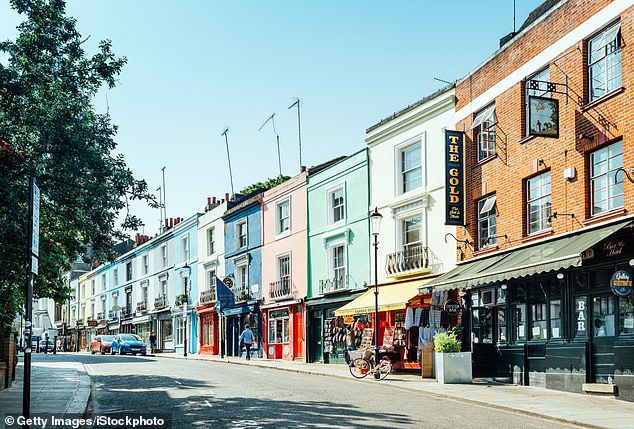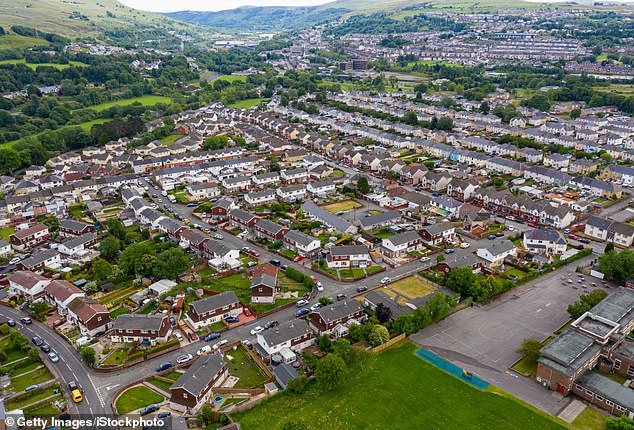What is the life expectancy in YOUR region? Interactive map reveals huge divide in Britain, with a 12-year gap between the best and worst districts
The huge gap in life expectancy in Britain is today laid bare by an interactive map showing how your region is faring.
Official data exposing the postcode lottery shows that children born in deprived parts of England, Wales and Northern Ireland are likely to die 12 years earlier than children in more affluent districts.
According to the Office for National Statistics (ONS), girls born in Kensington and Chelsea between 2020 and 2022 are expected to live to the age of 86.
The lifespan for boys is highest in Hart, Hampshire, where they are expected to reach 83 years.
But at the other end of the scale, boys in Blackpool are predicted to only reach their 73rd birthday, while girls in Blaenau Gwent, south-east Wales, are expected to live to just 78.
The ONS data also shows that average life expectancy in the three countries has fallen to the lowest figure in more than a decade. Boston in Lincolnshire and Bolsover in Derbyshire saw the biggest falls.
Statisticians suggested Covid could be behind the trend.
The The data also covers the period when Britain entered a crisis cost of living The crisis, which experts have warned, increases the risk of malnutrition due to high food and energy prices.
USERS OF THE MAILONLINE APP CAN USE BOTH TOOLS BY CLICKING HERE.
The estimates are based on a range of data, including historical and projected mortality rates.
Calculating the figures for men and women separately, using the mortality records from 2020 to 2022 for each age group, the probability of death and the number of survivors in each group.
British-born boys and girls are expected to live the longest, at 78.9 years for men and 82.8 years for women, according to the analysts.
Across the three countries, Wales scores the lowest at 77.9 years for men and 81.8 years for women.
Meanwhile, in Northern Ireland the figures were 78.4 and 82.3 respectively.
As a result, life expectancy for men in England and Wales is at its lowest level in more than ten years (2009/2011). In Northern Ireland it was the lowest since 2013/2015.
Among women, this was the lowest figure in England since 2009/2011. Growth was also the lowest in ten years for Northern Ireland (2010/2012) and Wales (2008/2010).
The ONS noted that children born in 2020 to 2022 will not necessarily live shorter lives than children born in previous years. If mortality rates improve, life expectancy will increase, it added.
According to the local authority, a boy born in Hart can expect to reach his 83rd birthday (83.74), the longest recorded life expectancy for men.
Meanwhile, someone born in Blackpool is likely to live to just 73 years (73.41 years), a gap of more than a decade.
Uttlesford in Essex came second with 82.69, while South Cambridgeshire came third with 82.65.
British-born boys and girls are expected to live the longest, at 78.9 years for men and 82.8 years for women, according to the analysts. According to the local authority, a boy born in Hart can expect to reach his 83rd birthday (83.74), the longest life expectancy ever recorded. In the photo Hartley in Hart

Meanwhile, someone born in Blackpool (pictured) is likely to live to just 73 (73.41), a gap of more than a decade. Uttlesford in Essex came second with 82.69, while South Cambridgeshire came third with 82.65
Meanwhile, a girl born in Kensington and Chelsea should live to 86 (86.34), but their peers in Blaenau Gwent are likely to live to just 78, a difference of 7.5 years.
Major disparities remain between the north and south, with nine of the ten local authorities with the highest life expectancy for men in the south of England declining. All 10 for women were in the south.
Among those with the lowest life expectancy for men, all ten were in the north of England. Meanwhile, for women, eight in 10 were in the north, with two in Wales.
The South West and South East of England recorded the highest life expectancy among both men (80 and 80.1 years) and women (83.9 and 83.8 years).
In total, seven in ten local areas (238) have experienced a decline in male life expectancy at birth over the past ten years.
Boston had the biggest decline at minus two years and one month, closely followed by Thurrock at minus one year and ten months.
Oxford recorded the biggest increase of the decade at one year and five months.
Among women, just under two-thirds of areas saw a decline in life expectancy, with the biggest falls recorded in Bolsover, Derbyshire and Barrow-in-Furness (minus one year and nine months).
Meanwhile, the largest increase was recorded in Ryedale (two years and three months).
Statisticians blamed the decline in life expectancy on Covid and the rise in mortality in 2020 and 2021.
But Covid is thought to have widened inequality even further.
Experts fear the pandemic has exacerbated problems around health inequalities, with some attributing this to healthcare cuts and budget cuts.

Major disparities remain between the north and south, with nine of the ten local authorities with the highest life expectancy for men in the south of England declining. All ten for women were in the south. A girl born in Kensington and Chelsea (pictured), who ranks first among girls, should live to be 86 (86.34)

Yet their peers in Blaenau Gwent (photo) will probably only live to be 78 years old, a difference of 7.5 years. The South West and South East of England recorded the highest life expectancy among both men (80 and 80.1 years) and women (83.9 and 83.8 years)
The data also covers the period when Britain entered crisis cost of living crisis.
Researchers have warned that this is leaving people in poorer households forced to choose between heating and eating and managing the stress of debt – all of which can worsen health in the long term.
Commenting on the figures, Veena Raleigh, a senior fellow at The King’s Fund, said: ‘Disparities in life expectancy are driven by socio-economic inequalities, including levels of income, education, housing and employment, with people in deprived areas having significantly shorter life expectancies . on average than people in less deprived areas.
‘Inequality in life expectancy was widening before the pandemic, and has increased further due to the disproportionate impact of Covid on people living in deprived areas.’
She added: ‘Much of this heavy burden of illness and death is caused by preventable conditions, such as heart disease, stroke and lung cancer, and hits disadvantaged communities hardest.
‘Bold strategies to reduce deadly risk factors such as smoking – for example the phased smoking ban – and obesity, earlier diagnosis and treatment of ill-health, and an intergovernmental strategy for tackling the determinants of ill-health in poor communities must be top priorities.
“Behind these statistics lie the devastating impact they have on individuals, families, communities and society as a whole.”
